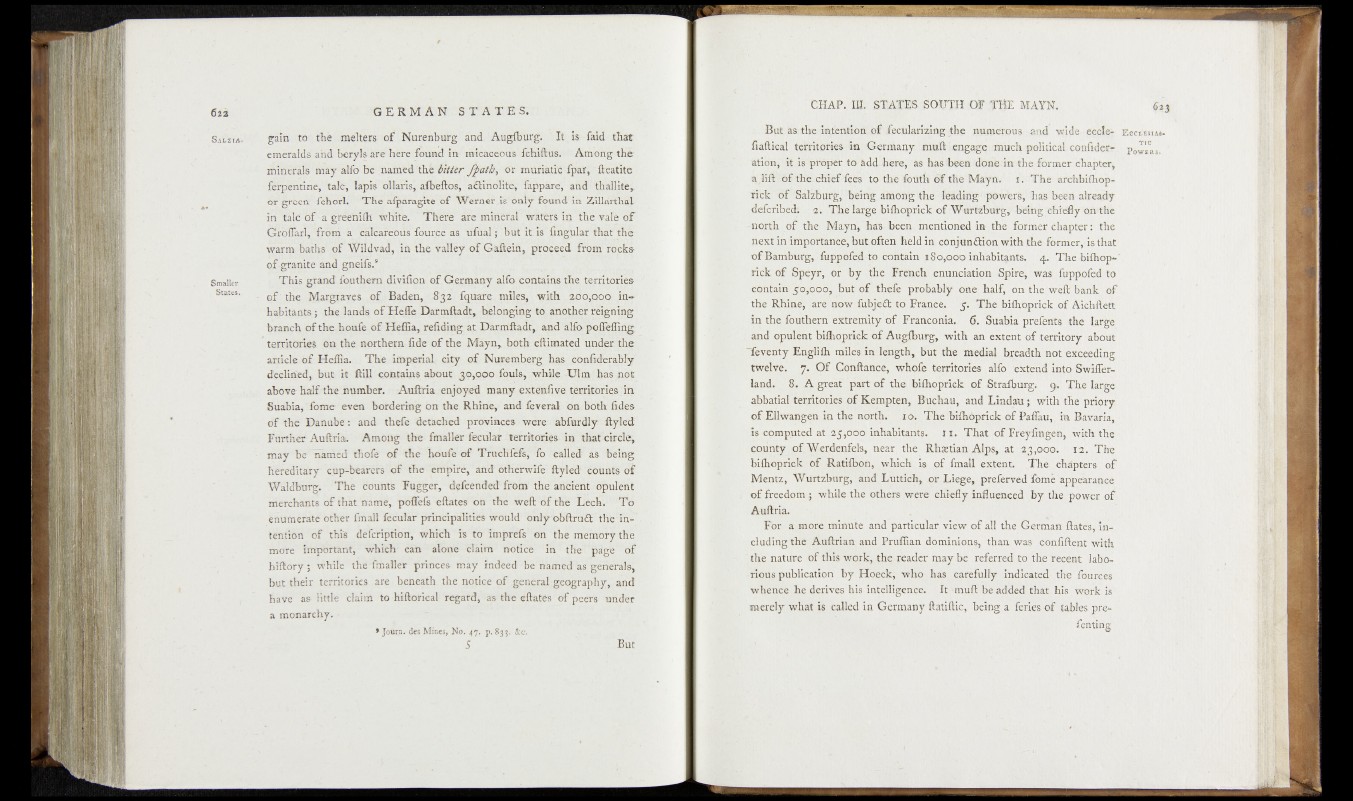
6 » i
S a l z i A.
Smaller
. States,
G E RMA N STAT ES . : :
gain to the melters of Nurenbufg and Augfburg. Tt is- faid that
emeralds and beryls are héte found in* micaceous fcbiftus. Among the
minerals may alfo be named the b itte r /p a th , ör muriatic fpar, fteâtite
féïpëntine, talc, lapis ollarisj alheftos,. adtinolitej fappàre, and thallite,.
or grée® fchorl.-iF&e.afparagite-'of Werner is only found in ZillartTiïd
in .talc of a greemfh white. * There are mineral waters iij the vale of"
Groflfarl, from a calcareous fourcé as ufual ; but it is* lingular that the
warm baths of Wildvad, in the valley of Gaftein, proceed from rocks,
of granite and gneils.9
This grand fouthem divifion of Germany alfó contains the territories
©f the Margraves of Baden, 832 fquare miles, with adö,póo inhabitants
; the lands ofTîefîè Darmftadt, belonging to another reigning
branch of the houfe of Heffia, refiding at Darmftadt, and alfo polïèfling.
territories ©a the northern fide of the Mayn, both eftimated under the
article of Heffia. The imperial, city of Nuremberg has çonfideraMy
declined, but it ftill contains about 30,000 fouls, while -Ulm has mot
above half the number. Auftria enjoyed many extenfive territories «1
Suabia, fotne even bordering on the Rhine, and lèverai on both fides
of the Danube : and tliefe detached provinces were abfnrdly ftyled
Further Auftria. Among the fmaller fecular territories in thatcirelir,
may be named thofe of the houfe of Truchféfs, fo called âô being
hereditary cup-beareTs of the empire, and othetwife ftyled "cohnis" of
Waldbtrrg. . The counts Fugger, dffeended from the andrent. opurent
merchants of tbatjiame, 'poffefs eftates on the weft of tftfc
enumerate other fmall fecular principalities would onlyobftruft the*®-
tënfiön of this defeription, which is to împrèfs" on the mérndfy tl|;
more important, which' can alone claim notice ";ib-
hiftory ; while the fmaller princes may indeed be named as generals,
but their territories are beneath the notice o f .general geography, and
have as little claim to hiftorical regard1, as the eftates o f peers under
a monarchy. *
* Journ. des Mines, No . 47. p. S33. &c.
I I ' But
M m I
T ic
P o w e r s .
CHAP. III. STATES SÖ SO T OF TI$E MAYN.
: But as the injuries:. efWéefilariliiiig $h§ numerous and wide bccler Eectiui
fiaftical territories in Germany mull Iengage; much political. confidec?
ationj % is proper to add-here, as has been done in the former chapter,
a lift lóf the. chief‘fofes to the feuth ©f the Mayn. 1. The archbifhop-
rick -df‘Salzburg, being among the leading powers, bas'bée'ri' already
deforibedi '2. The large bilhoprick of Wurtzburg, -béióg chiefly oh the
-north of the Mayn, has been mentioned in the Fpïmer chapter: the
next in'importancé, but often hddai^/cdhju^^dh with .the former,tis that
of Bamburg, fuppofed to contain 180,000 inhabitants. 4. Thebilhop*'
rick of Speyr, or by the French enunciation /S'pirej 'was fuppofed to
contain 50,009, but of thefe probably one- half,- on the weft bank of
the Rhinë, are now fubjedt to Frartcgj/f'y. The biffio|f|ckpf Aichftett
in the fouthern extremity of Franconia. 6 . Suabia preferits the largè
. and opulent bilhoprick of Augfburg, with an extent of territory about
"feventy Englifh miles in length, but the medial breadth 'exceeding
twelve.' 7.' Of Conftance, whofe territories alfo extend into Swiffer-
land. '8. A great part of the. bilhoprick of Stralburg.- 9,' The large
abbatial territories of Kempten, Bughau, and Lindau; with the priory
of Eilwangen in the north. 10. The bilhoprick of Baffiiu,, in Bayaria,
is computed at 25^öcto inhabitants. Ii. That of Freyfingen, with the-
county ofWerdenfels, near, the Rhaetian Alps, at 23,000. ' 12. The
bilhoprick, of iRatifbon, which is of fmall ext'ênjf., ,The chapters of
Mentz, Wilrtzburg, and Luttich, or Liege, preferved fomê appearance I
of freedom j while the others were chiefly influenced by the..pdvèër of.
Auftria.
For a more minute and particular view of all the GerrUaff Hates, im-
cluding the Auftrian and Pruffian dominions, than was Nfonfiftent with
the natdre of this work, the reader may bé referred -to the recent laho^ I
■rious publication by Hoeck, who has carefully indicated the fources
whence he derives his intelligence. It mull' be added that-his work is1'
merely what is called in Germany ftatiftic, being a feries of tables prefenting